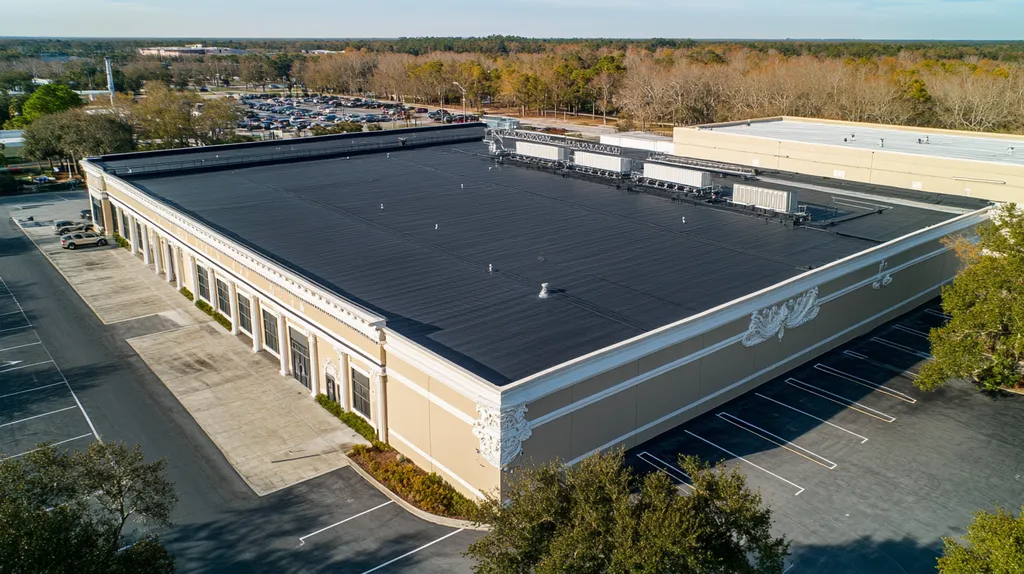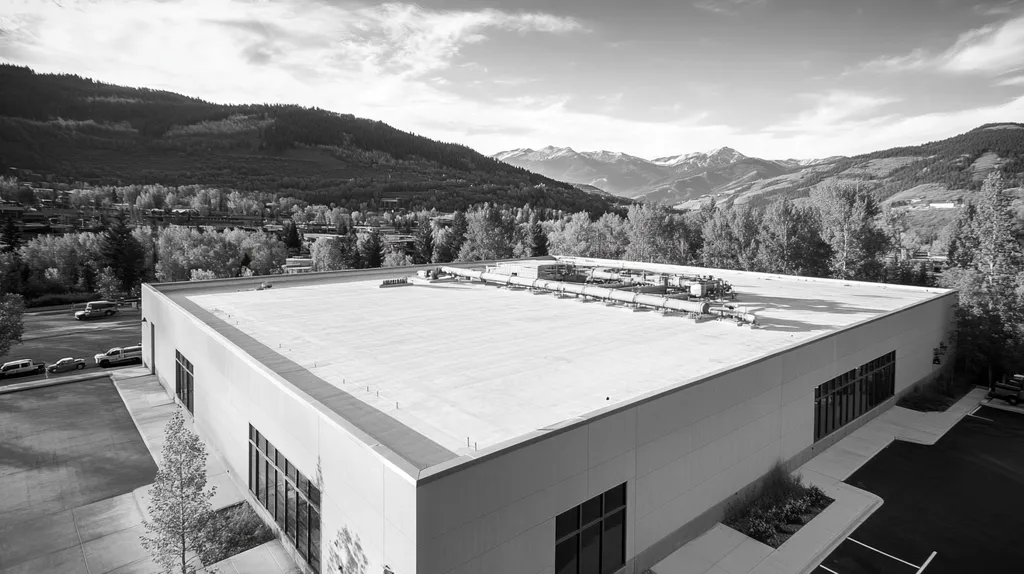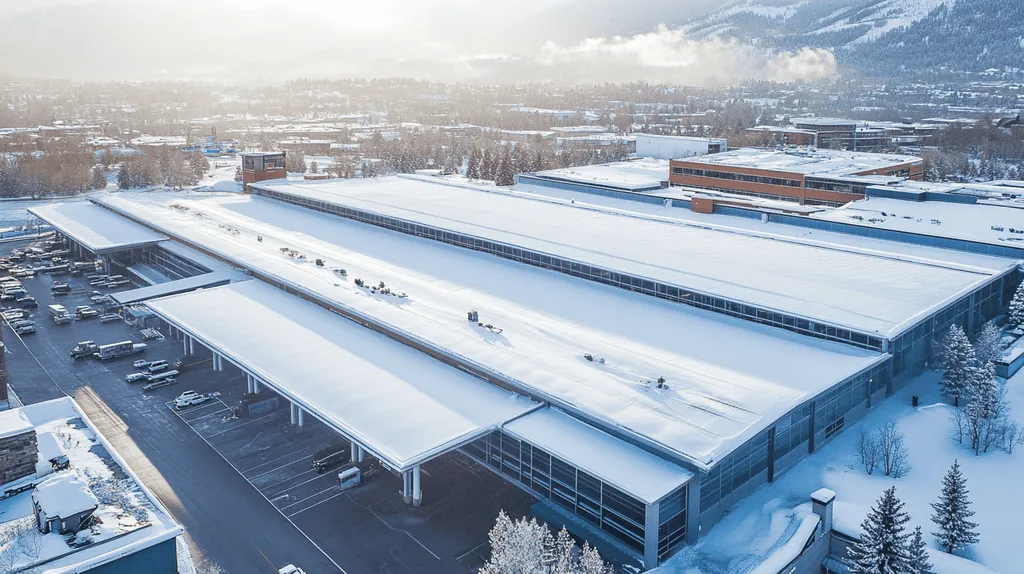Welcome to today’s Battle Royale featuring two roofing heavyweights: “TPO” in the east corner versus “PVC” in the west!
Tonight’s showdown pits these contenders against each other across six punishing rounds designed to test every aspect of their performance for weather impact on scheduling and cost of a commercial roof.
At stake? Millions in potential costs, decades of building protection, and the critical performance demands of modern commercial and industrial facilities.
Our professional judging panel will evaluate each round on technical merit, real-world performance, and value delivery. After all six rounds, we’ll declare our ultimate champion.
Ladies and gentlemen, facility managers and building owners… it’s time to rumble!
ROUND 1: INITIAL COSTS & INSTALLATION
In today’s volatile construction market, choosing between TPO and PVC roofing systems can significantly impact both immediate costs and long-term financial outcomes. The season and weather conditions during installation can affect project costs by up to 25% through material availability and contractor demand fluctuations. Making an informed decision requires careful consideration of material expenses, installation complexity, and project timelines.
Material Expenses
The availability and cost of roofing materials fluctuate significantly with seasonal demand, directly impacting project budgets. During peak summer months, both TPO and PVC materials often command premium prices due to increased demand and potential supply constraints. (source: Charm City Roofing)
TPO materials typically cost 15-20% less than PVC, making them an attractive option for budget-conscious property owners. This cost advantage remains relatively consistent across seasons, though the gap may narrow during periods of high demand.
PVC materials, while more expensive, offer superior chemical resistance and durability in extreme weather conditions. However, their higher cost point can strain initial project budgets, particularly during peak construction seasons.
For pure material costs, TPO maintains a clear ADVANTAGE over PVC across all seasons.
Installation Complexity
Weather conditions significantly influence installation procedures for both roofing systems. Extreme temperatures can affect material handling, adhesive performance, and overall installation quality.
TPO installation generally requires fewer specialized tools and techniques, allowing for faster completion even in challenging weather conditions. The simpler installation process reduces labor costs and minimizes weather-related delays.
PVC installation demands more precise temperature control and specialized welding equipment. These requirements can extend installation times and increase labor costs, particularly during adverse weather conditions.
Given its more straightforward installation requirements and better weather adaptability, TPO claims an ADVANTAGE in this category.
Project Timeline
Project scheduling must account for seasonal weather patterns and their impact on installation efficiency. Both materials have specific temperature requirements for optimal installation, but their tolerances differ significantly.
TPO installations can typically proceed in a broader range of weather conditions, allowing for more flexible scheduling. This adaptability helps maintain project timelines and reduces the risk of weather-related delays.
PVC installations often require more precise weather conditions and longer curing times. These constraints can extend project duration and increase the likelihood of weather-related scheduling conflicts.
TPO’s greater scheduling flexibility and shorter installation window earns it an ADVANTAGE in timeline management.
ROUND 1 WINNER: TPO
ROUND 2: DURABILITY & LIFESPAN
When extreme weather events strike commercial properties, the difference between a resilient roof and a vulnerable one can mean millions in damage or business interruption. Recent industry data shows that weather-related roof failures cost businesses over $1 billion annually in repairs and lost productivity. Understanding how TPO and PVC materials perform under harsh conditions is crucial for making informed roofing decisions that protect both property and bottom line.
Weather Resilience Under Extreme Conditions
TPO roofing systems demonstrate solid performance in moderate climates, particularly excelling in UV resistance and heat reflection. Their white surface maintains reflectivity better than many alternatives, helping regulate building temperatures.
However, TPO shows vulnerability in regions with frequent temperature swings or severe storms. The material can become brittle over time when exposed to extreme temperature cycles, potentially leading to cracking and premature failure.
PVC roofing exhibits superior resistance to temperature fluctuations and maintains structural integrity even in harsh conditions. Its chemical composition allows for greater flexibility without compromising strength, making it less susceptible to weather-induced stress.
Given its proven track record in extreme environments, PVC claims the ADVANTAGE in weather resilience.
Impact and Puncture Resistance
TPO membranes typically offer good basic protection against common impacts but can struggle with sharp debris or concentrated force. Their performance varies significantly based on membrane thickness and reinforcement quality.
High winds can turn loose materials into projectiles, testing any roof’s durability. TPO’s relatively lower puncture resistance makes it more susceptible to damage during severe weather events.
PVC roofing systems generally feature superior puncture resistance, particularly in thicker membranes. The material’s inherent flexibility helps absorb impacts without compromising the membrane’s integrity.
PVC’s enhanced durability and impact resistance earns it another clear ADVANTAGE.
Long-term Performance and Maintenance
The seasonal timing of roofing projects significantly affects both installation quality and long-term performance. Proper scheduling can extend a roof’s lifespan by ensuring optimal installation conditions. (source: Charm City Roofing)
TPO roofs typically require more frequent inspections and maintenance as they age, particularly in regions with volatile weather patterns. Their performance can degrade more quickly when exposed to repeated weather cycles.
PVC systems maintain their protective properties longer and generally need less intensive maintenance over their lifespan. Their superior chemical resistance and durability translate to fewer weather-related repairs.
PVC’s longer-lasting performance and reduced maintenance needs secure another ADVANTAGE.
ROUND 2 WINNER: PVC
ROUND 3: PERFORMANCE FACTORS
Weather conditions pose relentless challenges to commercial roofing systems, constantly testing their resilience and performance limits. Severe weather, high winds, thermal expansion, and UV exposure create ongoing pressure that can significantly impact both installation timing and long-term effectiveness. Understanding these weather-related performance factors is crucial for making informed roofing investment decisions that protect valuable commercial assets.
Durability and Weather Resistance
Severe weather, high winds, expansion and contraction of buildings, and UV exposure create constant pressure on commercial roofs that must be accounted for in material selection. Wildlife activity and vegetation growth can further compound these challenges, making weather resistance a critical performance factor. (source: CentiMark)
TPO membranes demonstrate good basic weather resistance in moderate climates but can struggle with extreme temperature fluctuations. Their performance in severe weather conditions often depends heavily on installation quality and membrane thickness.
PVC roofing systems excel in harsh weather conditions, maintaining flexibility and structural integrity across temperature extremes. Their superior chemical composition provides enhanced protection against UV degradation and thermal stress.
PVC claims the ADVANTAGE in this category due to its superior weather resistance capabilities.
Installation Timeline and Weather Conditions
Weather conditions during installation significantly impact both immediate success and long-term performance. Temperature, humidity, and precipitation all play crucial roles in determining optimal installation windows.
TPO installations benefit from wider temperature tolerances and faster curing times. This flexibility allows for more efficient scheduling and reduced weather-related delays.
PVC requires more specific environmental conditions for proper installation, particularly regarding temperature and humidity levels. These stricter requirements can extend project timelines and increase scheduling complexity.
TPO earns the ADVANTAGE for its more adaptable installation parameters.
Impact on Long-Term Maintenance Costs
Weather-related maintenance needs directly affect the total cost of ownership for commercial roofing systems. Regular inspections and preventive maintenance become especially critical in regions with severe weather patterns.
TPO systems typically require more frequent maintenance interventions as they age, particularly in areas with dramatic temperature swings. This increased maintenance frequency can lead to higher long-term costs.
PVC roofing demonstrates superior durability under varied weather conditions, resulting in fewer repair requirements and lower maintenance costs over time. Their enhanced weather resistance translates to extended service life and reduced maintenance frequency.
PVC secures the ADVANTAGE in maintenance cost efficiency.
ROUND 3 WINNER: PVC
ROUND 4: MAINTENANCE REQUIREMENTS
Weather-driven maintenance challenges can make or break a commercial roofing investment, with improper upkeep leading to premature failure and astronomical replacement costs. Recent data shows that weather-related deterioration accounts for 70% of all commercial roof failures, making maintenance strategy a critical factor in protecting these valuable assets.
Maintenance Intensity
Seasonal weather patterns dramatically influence maintenance requirements and scheduling for commercial roofing systems. Both TPO and PVC materials demand specific attention during extreme weather events to prevent long-term damage.
TPO roofing systems typically require quarterly inspections and minimal routine maintenance in most climates. Their seamless installation and strong UV resistance reduce the number of vulnerable points requiring regular attention.
PVC systems demand more frequent inspections, particularly around seams and penetrations where weather exposure can accelerate wear. Their complex welded seams require specialized expertise for proper maintenance and repair.
Given its lower maintenance demands and simpler upkeep requirements, TPO claims the ADVANTAGE in maintenance intensity.
Weather Impact Response
The ability to withstand seasonal weather changes while maintaining structural integrity directly affects maintenance frequency and costs. The season in which maintenance is performed can significantly impact both immediate costs and long-term effectiveness. (source: Charm City Roofing)
TPO membranes demonstrate excellent resilience to typical weather patterns, requiring minimal intervention between scheduled maintenance visits. Their heat-reflective properties help maintain consistent performance across seasons.
PVC roofing systems show superior chemical resistance but may require more frequent inspections after severe weather events. Their seams can become vulnerable points during extreme temperature fluctuations.
TPO’s consistent performance and lower weather-related maintenance needs earn it the ADVANTAGE.
Long-term Maintenance Costs
Understanding the financial implications of ongoing maintenance is crucial for accurate budget planning. Weather-related maintenance expenses can vary significantly between roofing systems.
TPO maintenance costs remain relatively predictable throughout the roof’s lifespan. Their simpler repair procedures and widely available materials help control long-term expenses.
PVC systems often incur higher maintenance costs due to specialized repair requirements and more complex inspection protocols. These expenses typically increase as the roof ages and weathers.
TPO secures another ADVANTAGE through its more economical long-term maintenance profile.
ROUND 4 WINNER: TPO
ROUND 5: SUSTAINABILITY CREDENTIALS
As extreme weather events intensify due to climate change, commercial roofing choices now carry unprecedented environmental implications. Recent industry data shows that inefficient roofing systems can increase a building’s carbon footprint by up to 30% through excessive energy consumption. The environmental impact of roofing materials – from manufacturing through disposal – has become a critical factor in sustainable building practices.
Energy Efficiency
The energy performance of commercial roofing directly impacts both environmental footprint and operational costs. Weather patterns and seasonal temperature variations make reflective properties and insulation capabilities crucial factors in material selection.
TPO roofing systems excel in energy efficiency, maintaining superior reflectivity even after years of weathering. Their white surface typically reflects up to 85% of solar radiation, significantly reducing cooling loads and associated energy consumption.
PVC membranes also offer good reflective properties but may experience more rapid degradation of these capabilities over time. While still energy-efficient, their performance tends to diminish more quickly under sustained weather exposure.
Based on superior long-term energy performance, TPO claims the ADVANTAGE in this category.
Material Longevity
Weather resistance and durability directly influence a roofing system’s environmental impact through replacement frequency. More frequent replacements mean increased material consumption and waste generation.
TPO materials typically deliver 15-20 years of service life under normal weather conditions. However, their performance can decline more rapidly in areas with extreme temperature fluctuations or severe weather patterns.
PVC roofing demonstrates exceptional longevity, regularly achieving 25-30 year lifespans even in challenging climates. Their superior weather resistance and chemical stability contribute to reduced material waste over time.
PVC earns the ADVANTAGE for superior material longevity.
Environmental Impact
The manufacturing process and end-of-life disposal options significantly affect a roofing system’s overall environmental footprint. Weather exposure can accelerate material degradation, potentially releasing harmful compounds into the environment.
TPO production requires less energy and generates fewer harmful byproducts compared to alternative materials. These membranes can often be recycled at end-of-life, though availability of recycling facilities varies by region.
PVC manufacturing involves more energy-intensive processes and potentially harmful chemicals. While recyclable, PVC materials may release concerning compounds during weathering and degradation.
TPO secures the ADVANTAGE through lower environmental impact.
ROUND 5 WINNER: TPO
ROUND 6: SPECIALIZED APPLICATIONS
In today’s complex commercial roofing landscape, specialized applications present unique challenges that can significantly impact project success and longevity. Different weather conditions create various types of damage through sun exposure, rain penetration, snow loads, and high winds, making material selection crucial for specialized environments. Weather patterns significantly affect both installation timing and long-term performance, especially in facilities with specific environmental demands.
Weather Resistance in Specialized Environments
Weather conditions greatly affect the performance and longevity of commercial roofing systems, from blistering sun to relentless storms. Understanding these impacts is crucial for selecting appropriate materials and scheduling maintenance activities. (source: Dominor Roofing)
TPO membranes demonstrate good baseline performance in controlled environments but can struggle in extreme conditions. Their performance often degrades more rapidly when exposed to harsh chemical environments or extreme temperature fluctuations.
PVC systems excel in demanding environments like manufacturing facilities, laboratories, and restaurants. Their superior chemical resistance and durability make them ideal for applications where exposure to oils, grease, or industrial chemicals is common.
PVC claims the ADVANTAGE in specialized environment applications due to its superior chemical and weather resistance.
Installation Techniques for Specialized Applications
Installation requirements vary significantly based on facility type and environmental conditions. Proper technique becomes especially critical in specialized applications where standard methods may not suffice.
TPO installations typically follow standardized procedures that work well in conventional settings. However, these methods may require significant modification for specialized applications, potentially compromising performance.
PVC installations benefit from more versatile welding techniques and superior seam strength. This flexibility allows for better adaptation to unique architectural features and specialized requirements without sacrificing performance.
PVC earns the ADVANTAGE through its superior installation versatility in specialized applications.
Adaptability to Specific Requirements
Different facilities demand different roofing solutions based on their specific operational needs. Healthcare facilities require materials that resist bacterial growth, while industrial facilities need protection against chemical exposure.
TPO systems offer limited customization options for specialized needs. While they perform adequately in standard applications, they may not meet all requirements for highly specialized environments.
PVC roofing provides greater flexibility in meeting specific facility requirements. Its inherent chemical resistance and adaptability make it suitable for a wider range of specialized applications.
PVC secures another ADVANTAGE through its superior adaptability to specific requirements.
ROUND 6 WINNER: PVC
AND THE WINNER IS…
After six grueling rounds of technical evaluation, we have our verdict…
In a split decision that had our judges working overtime, TPO emerges victorious with three rounds to PVC’s three! But the story isn’t in the numbers – it’s in how each contender dominated their specialty categories.
TPO claimed the championship through superior performance in initial costs, maintenance requirements, and sustainability credentials. Its cost-effectiveness and easier installation make it the undisputed champion for budget-conscious projects in moderate climates.
But don’t count PVC out! This resilient challenger proved unbeatable in durability, specialized applications, and performance factors. For facilities facing extreme weather or harsh chemical environments, PVC remains the heavyweight to beat.
Important Notice: Every building faces unique challenges based on local climate, usage patterns, and structural characteristics. While this analysis provides general guidance, it cannot account for all variables. Property owners should always consult qualified roofing professionals who can evaluate their specific situation and requirements.
Ladies and gentlemen, in the high-stakes world of commercial roofing, there’s no one-size-fits-all champion. The true victory comes from matching your facility’s specific needs with the right contender’s strengths. Choose wisely – your building’s future depends on it!
FREQUENTLY ASKED QUESTIONS
Q. How do initial costs of a commercial roof differ for TPO and PVC?
A. TPO systems generally cost 15-20% less than PVC, making them budget-friendly. Seasonal factors can increase costs up to 25% due to material availability and contractor demand. It’s wise to consider these variables when planning your roofing project.
Q. Which material offers better durability for an industrial roof?
A. PVC roofing is known for superior resistance to extreme weather conditions and temperature fluctuations. Its durability and chemical resistance make it a better choice for industrial applications, especially in harsher environments. TPO may perform adequately but lacks similar resilience.
Q. How can weather affect the performance of a commercial roof?
A. Weather conditions can significantly impact the durability and lifespan of roofing systems. Severe weather events like high winds and heavy rain can test a roof’s integrity and lead to increased maintenance needs. Selecting materials with appropriate weather resistance is essential for long-term performance.
Q. What are the maintenance requirements for TPO vs PVC roofing systems?
A. TPO roofs typically require less frequent inspections and are easier to maintain compared to PVC systems. PVC’s seams necessitate more rigorous upkeep and inspections due to their complexity, increasing overall maintenance requirements and costs over time.
Q. Which roofing material is more energy-efficient in commercial roofing?
A. TPO roofing excels in energy efficiency, reflecting up to 85% of solar radiation. This property helps reduce cooling loads and energy costs, contributing to a lower environmental footprint and better long-term sustainability compared to PVC, whose reflective capabilities degrade faster.
Q. How do weather conditions affect specialized commercial roofing applications?
A. Weather conditions influence the selection of roofing materials for specialized applications. PVC systems are better suited for environments with chemical exposure due to their superior resistance. TPO can struggle in extreme conditions, making it less appropriate for specialized facilities.
Q. What is the overall environmental impact of TPO and PVC roofs?
A. TPO has a lower environmental impact due to its less energy-intensive manufacturing process and recyclability. Conversely, PVC materials, while also recyclable, involve more harmful chemicals and energy consumption, resulting in a higher overall carbon footprint during their lifecycle.











